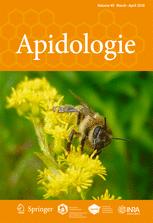Ver ítem
- xmlui.general.dspace_homeCentros Regionales y EEAsCentro Regional Santa FeEEA RafaelaArtículos científicosxmlui.ArtifactBrowser.ItemViewer.trail
- Inicio
- Centros Regionales y EEAs
- Centro Regional Santa Fe
- EEA Rafaela
- Artículos científicos
- Ver ítem
Risk factors associated with failures of Varroa treatments in honey bee colonies without broodless period
Resumen
The treatment against Varroa destructor has become a basic tool in beekeeping practices, mainly during autumn. The treatment effectiveness should be improved by identifying variables affecting the final outcome. The aim of this study was to identify the risk factors associated with the treatment outcome achieved during autumn control of Varroa destructor. The mite infestation after treatment was evaluated in 62 apiaries and data regarding management
[ver mas...]
The treatment against Varroa destructor has become a basic tool in beekeeping practices, mainly during autumn. The treatment effectiveness should be improved by identifying variables affecting the final outcome. The aim of this study was to identify the risk factors associated with the treatment outcome achieved during autumn control of Varroa destructor. The mite infestation after treatment was evaluated in 62 apiaries and data regarding management practices were collected by means of a questionnaire. A mixed-effects model was constructed to associate management variables with the risk of treatment failure occurrence. Colonies with high mite levels prior to treatment (P = 0.002) and owned by beekeepers who did not frequently replace queens (P = 0.001) were associated with a higher risk of treatment failure. Other beekeeping practices indirectly improved treatment effectiveness. An integrated strategy for controlling mites that includes chemotherapy and suitable beekeepers management is needed to keep mite populations low during winter.
[Cerrar]

Fuente
Apidologie 46 (5) : 573–582 (September 2015)
Fecha
2015-09
ISSN
0044-8435
1297-9678
1297-9678
Formato
pdf
Tipo de documento
artículo
Palabras Claves
Derechos de acceso
Restringido
 Excepto donde se diga explicitamente, este item se publica bajo la siguiente descripción: Creative Commons Attribution-NonCommercial-ShareAlike 2.5 Unported (CC BY-NC-SA 2.5)
Excepto donde se diga explicitamente, este item se publica bajo la siguiente descripción: Creative Commons Attribution-NonCommercial-ShareAlike 2.5 Unported (CC BY-NC-SA 2.5)

